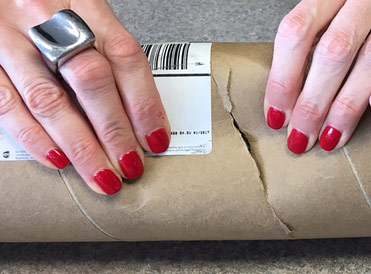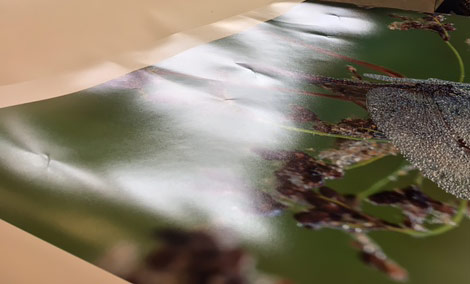www.lumen-perfectus.com
No Ship, Sherlock
“Uh-oh” interjection—used to indicate dismay or concern.
Merrian-Webster Dictionary
The “art” of landscape and wildlife photography, including the making of fine-art prints, requires equipment, material, software, and, to do it well, at least a little bit of skill. The necessary level of these things is variable, depending on the desired quality of the final product. That product might be a Web site or blog, a social media posting, a book, a presentation, a print, a stock image, publication in a magazine, etc. I was not surprised to discover, not long after I began making prints, that the demands of my own photography and the product I wished to create barely exercised the equipment. That included a large-format printer, a finicky machine that performs best when used more frequently than my own work could possibly require. I also needed a way to pay for all of this stuff.
The obvious solution to these issues was to offer “photographic services” to others who preferred not to let that kind of work take over their lives as I had. So that's what I did. I started by making a list of the services I'd provide, and setting prices. I wanted to do this work, but I didn't (and still don't) want to do too much of it. I also expected to do very good work and knew that would require significant time, so I set my prices accordingly. I put a Digital Photographic Services page on my site so I could easily refer people to it. Both the services offered and the prices have evolved over time.
My total marketing effort consisted of mentioning this to a couple of local photographers, people I knew had small table-top printers but might occasionally want larger prints. I also told my favorite local framer, and it's from him I received my first job. It almost ended this little side-business before it started.
Half-a-Million Clicks
The framer had a customer who had some black & white photos from early in the 1900s of his tribal ancestors (I live on one of Montana's several Indian reservations). “Terrible” might describe the condition of these little prints. By the time I finished the job, much stronger language seemed appropriate. I quoted on scanning the pictures, digitally restoring them, and making the requested number of prints in various sizes. I wanted the job so I quoted low, but to make up for that stupidity I also grossly underestimated the time required. I had only myself to blame, in part because once I started, I couldn't quit until the restorations were nearly perfect.
I used the current (at the time) version of Photoshop on a Windows PC. I made extensive use of the clone tool to remove a zillion little nits, scratches (some not so little), tears and creases, and other surface damage. At the time I had only a mouse; this was long before I had the Wacom tablet I use now. It seemed like I was doing life-cycle testing of the mouse button, but it survived those thousands of clicks.
Since then I've done a number of restoration jobs, and used that earlier experience to better quote the prices. I've made a number of prints for painters, some of which required setting up my camera and lights to photograph the original painting, while others had had very nice scans made somewhere and simply brought me the resulting files. Painters are the only clients who insist on calling ink-jet reproductions of their paintings “giclées”. Well, fine.
However, most of my work has been for other photographers, which is what I'd intended in the first place. These have mostly been local folks. Some bring me their files and we sit together at the computer while I make adjustments or otherwise optimize their files for printing. Others send files in various ways, and I either deliver or they pick up their prints. One of my clients is a local weekly newspaper that offers for sale prints of pictures they've used in their articles. As you'd expect, most of these include peoples' kids in parades, school events and sports, etc. I've also done some very interesting jobs for the Tribal government and their high school and college here on the reservation.
All of this has been via “word of mouth”; I've never advertised.
But It's Not All Local
I don't get many orders for my photos via the Web site, but when I do I make the prints as usual, and then package them for shipping to the customer. Likewise, I don't get many “services” print jobs via the site, but there have been a few, and I've got several regular customers scattered around the U.S. If printing is required, I must also package the prints. I've long used the U.S. Postal Service's Priority Mail service for this. Most of the time it's fast, most of the time it's reliable, and most of the time the prints arrive at their destination in good condition. Most of the time.

The 'last straw' crushed shipping tube, courtesy of UPS. (Client photo.)
When things go wrong, the USPS is worthless. If a package disappears, well, that's too bad. They do not guarantee delivery. Right, because who would expect that? If the package arrives damaged, that's too bad, too, even if I've insured it. It seems they'll take my money to insure a package, but if that package contains paper, that is, printed materials, they don't honor that insurance. It does not, apparently, apply to such contents.
A March, 2017, job had me sending a 3-inch mailing tube, containing two 20-inch x 30-inch prints, to an address across the country. As usual, I sent it via Priority Mail, and as usual I was told to expect delivery in three business days. Historically that's worked pretty well, so I expected it to work again. It didn't. A week passed but the package didn't arrive. After ten days I went to the local USPS office from which I'd mailed the thing, and while the clerk there was sympathetic, she looked on their computer and found nothing (same as I did at home). She said after 30 days I could file a claim on-line. But my client didn't have 30 days. Just as I prepared to make, package, and ship the prints again, the package arrived. Not obviously damaged, upon unpacking the mailing tube one of the prints was found to be unusable. The client emailed, with the subject line, “Uh-oh”. I then made a replacement print, packaged that in a 4-inch tube, and shipped it via United Parcel Service (UPS). Playing 50-questions with the clerk at our local UPS Store I learned they'll do a lot more to track down late or missing packages, including tubes containing paper products. I felt a bit more assured that this package would arrive as expected.
It did, and had been crushed at some point during the ride east, and the print inside was ruined.
No Ship

The damage to the print from the tube shown above is obvious. (Client photo.)
For me that was the end of the line. It's not that I, or my clients, have suffered a large number of lost or damaged shipments. More, it's that I put a great deal of time, effort, and care into making prints for my clients (and for me, of course). I package them carefully in quality materials. My clients tend to order things when they need them, often having no extra time for do-overs.
Perhaps of equal significance, I just hate packaging prints for shipping, so much so that it takes the fun out of making the prints (something I really enjoy) in the first place. It takes a lot of time to cut interleaf paper, carefully stack and align each print and interleaf sheet, roll the stack and secure it, print labels, and of course deliver to the shipper. I'm a one-person shop, and could make much better use of my time.
So I've decided I will. I'm no longer shipping prints. I've got enough local work to keep me busy and fund my passion for photography; I didn't really ship all that much anyway. This has turned out to be a great relief! I do some light-weight packaging so my local clients can get their work home, but this is quick and easy compared to packaging for shipping. I no longer worry about packages getting to their destinations in good condition. I no longer have to deal with the “gosh, that's too bad, come back when we can ship your next package” attitude at the Post Office.
Thousands of businesses ship millions of fragile products and have minimal problems. It can be and is done every day. But not by me anymore. I've removed all of the purchase a print links from the site, and updated all pages that mentioned or described purchasing prints via the site. A few of my long-distance clients must now find a new printer. That won't be difficult, but for that inconvenience I'm sorry, and sad to lose those clients. Otherwise, this is a burden lifted from my shoulders, and I'm very happy about that.
April, 2017
All products and brand names mentioned are trademarks or registered trademarks of their respective owners.